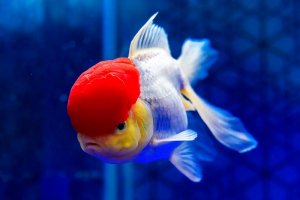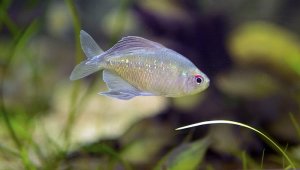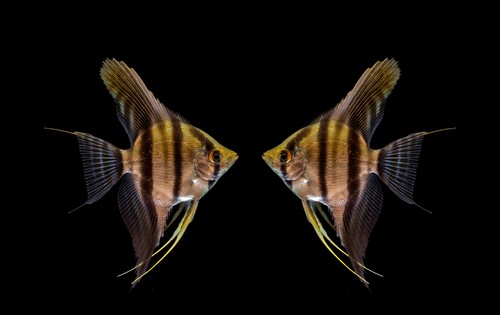
Angelfish breeding is relatively simple if you know how mating aquarium fish works. This species has a few subtle differences, but the general idea remains the same. So if you’re looking to answer “how do angelfish mate?” you’re definitely in the right place.
As freshwater fish, their colors are natural and lively, helping them stay relevant among the most popularly collected fish. Any seasoned aquarist will tell you that breeding them is a rewarding experience and that the possible profits are genuine. More so if you have a tank with a variety of patterns and colors.
Breeding angelfish is undoubtedly a good idea, but the process comes with a few challenges. First, this fish species is one that highly values privacy. When they are in a tank, they prioritize areas that seem untouched by any other tank mates. Also, they are a rare fish species that prefer to choose their own mates.
Therefore, they are likely to pair up while in the larger tank. So, spotting pairs is essential to ensure you place the right fish together for mating. If you can successfully set everything up, the couple will quickly provide fertilized eggs.
Setting Up An Angelfish Tank For Breeding
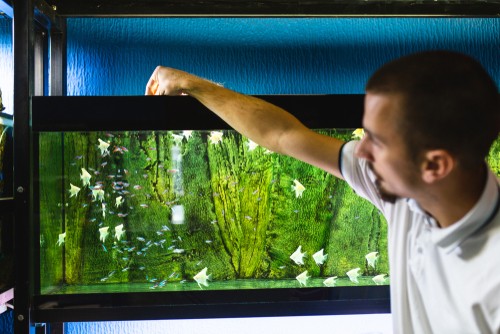
Tank conditions for these fish are similar to other freshwater species during mating season. Having over 20 gallons of water is a good way to get started. There needs to be enough space within your tank to prevent your angelfish from feeling cramped and stressed.
The 20-gallon tank also has to be something your fish are used to. That’s why it’s ideal to set up this tank months in advance. Ideally, it should be done between 2 to 3 months before.
● Use A Sponge Filter: Introducing a sponge filter to your tank can also help with the setup process for mating. Your male and female angelfish should be well adapted and comfortable with similar conditions and diets. The best filter to use is an active sponge filter. It’s a great way to handle a tank’s high levels of ammonia and nitrates. Plus, it’s also a budget-friendly way to keep your tank clean.
With a sponge filter, you can avoid the dangers of aggressive filters that tend to mess with the mating process of fish. All you’ve got to do is clean the filter regularly, at least every two weeks, and your tank should be fine.
● Change Water Frequently: Introduce frequent water changes. This is mainly to reduce the chances of toxins accumulating in the tank. With 20 gallons, there’s a good chance that certain harmful toxins can cause serious harm to your angelfish
It would be best to change only a small portion of water in each change as angelfish are particularly resistant to sudden changes. However, you’ll be fine with swapping out at least 40% of your water frequently. It will be ideal if you do this at least every 2 or 3 days. The water needs to be kept at temperatures of at 72-82 degrees Fahrenheit. With these in place, your angelfish will be in safe conditions for spawning angelfish fry.
Pairing Your Angelfish
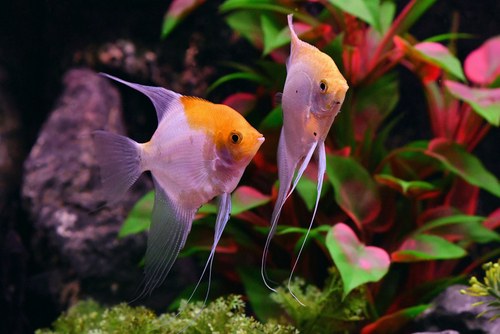
Angelfish finding their own pairs is usually expected. To encourage the pairing process for mating, it’s best to choose between 4 to 12 fish for breeding. This high amount allows them to view multiple options as they select their own breeding mates. Shape, color, and fins are important aspects of this process, so you should stick to the ones that stand out among the fish population.
Distinguishing between a male and female angelfish isn’t particularly easy. There’s an apparent similarity between the two. But most breeders will be able to help you identify them. Therefore, you’re better off observing external features that make them look healthier than the rest.
For example, the fins and gills should be smooth and free of fraying, as this indicates a sign of good health. Also, the angelfish you have must be obtained from an established breeder if you want to avoid any future fry health problems. Buying online is possible if you specifically adjust your search query to “Scalare angelfish breeder” in your area. Like always, a reputable source is your best bet over the price.
Identifying A Pair
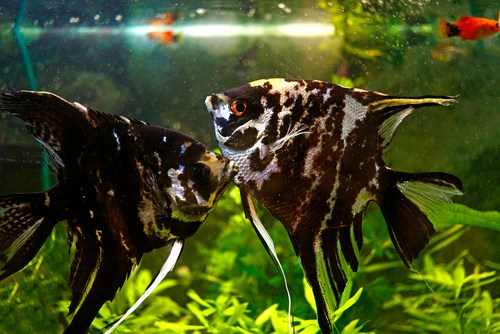
Once your breeding pair has reached between 6 and 12 months, their sexual maturity is at its peak. The best tank mate for angelfish at this point is their fellow angelfish. How do angelfish mate? Well, at this age in their lifespans, they’ll be showing signs of readiness to engage in spawning, claiming certain sections of your tank as their own.
Look closely at the behavior of angelfish in the tank and if you think you’ve observed a pair, watch them closely for a day and see if they are constantly next to each other.
Now that you’ve got the right pair, it’s best to get them started with breeding as soon as you can. It’s preferable if you use a spawning tank or a divider to keep them away from the other fish that aren’t in the process of breeding. With a divider, your chosen pair will stay in similar conditions to the main tank, but they have the privacy to engage in spawning, share meals and stay close to each other.
How To Make Your Angelfish Mate
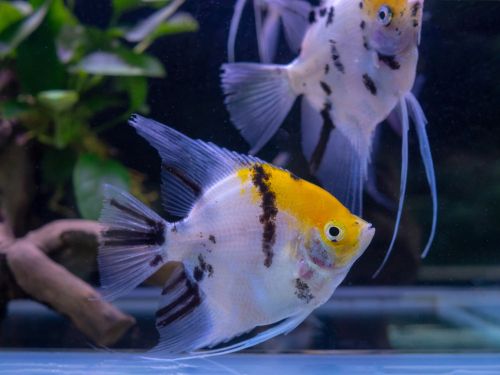
First, their diet should be spectacular before and during mating. This fish species is usually one that has a large appetite when it’s time for mating. Therefore, feeding them 2-4 times daily is a good idea. In addition, explicitly choosing foods rich in proteins, like white worms, bloodworms, and brine shrimp, would be a significant contribution.
If your angelfish refuse to eat any food after 3-5 minutes, it’s best to get rid of the food particles in your tank. After all, wasted food can lead to a buildup of toxic minerals.
1. Signs Of Readiness For Breeding In Angelfish
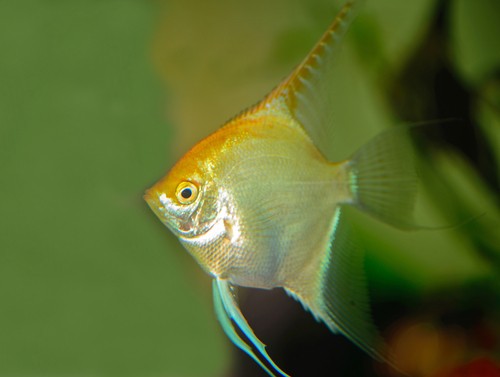
When an angelfish is ready to mate, you’ll notice specific attributes. With the female, her belly will begin to swell noticeably. She’ll also develop a new organ around her ventral fin called the papilla. Same with the male. However, you’ll find that the female has a more prominent papilla than her male counterpart. This is a great way to tell the sex of your angelfish during breeding.
2. Angelfish Mating Process
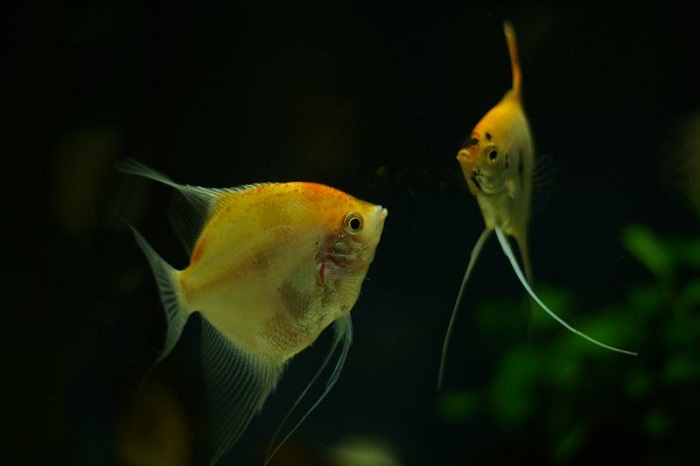
How do angelfish mate? Angelfish have a reasonably straightforward mating process, mainly because they get to pick their partners. You’ll even begin to wonder, do angelfish mate for life?
Angelfish that are mating will behave very similarly to animals that are fighting. If you’re able to pay close attention, you can avoid halting the mating process. When you notice the changes in their bodies highlighted above, you stand a good chance of judging whether or not they were mating.
Their swimming pattern is also a dead giveaway, as the males tend to swim in a horizontal fashion, swinging from mouth to tail. Meanwhile, females hold their mouths higher than their tails.
The female angelfish will release her eggs into the water within 5-8 days of being kept in a mating tank or divider with good water conditions. It’s your duty to ensure that her eggs are met with good air circulation. At the same time, you’ll also need the male angelfish to spray these eggs, so you shouldn’t be too quick to move them around.
Once the eggs are fertilized, it’s time to give them air circulation. You can let this happen naturally when your angelfish use fins to fan the eggs.
Bottom Line
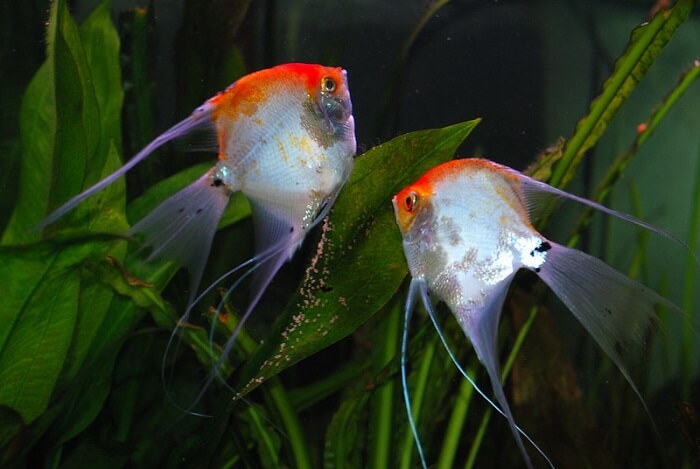
Breeding angelfish isn’t necessarily an easy task, but with enough knowledge, you can simplify the process significantly. Be sure to attend to their needs closely, and you should have no problem handling an entire tank’s worth of fish. Patience is also a significant value here, so don’t underestimate allowing your fish to adapt to breeding conditions.



